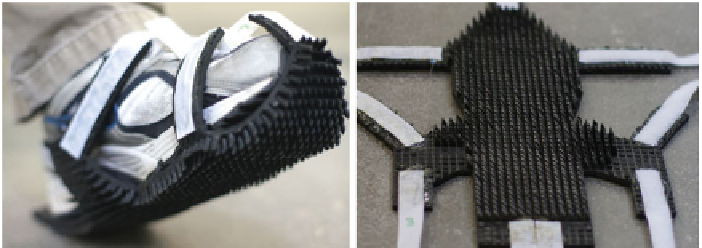Biomedical Engineering Reference
In-Depth Information
(a)
(b)
Fig. 14.2 a
Attachments were designed to fit around the user's existing shoes and induce an
angular rotation of the user's foot about the heel.
b
The
bottom
of each shoe attachment comprised
a multitude of rubber floor contact elements that were diagonally trimmed, causing them to buckle
and pull towards one side as weight is applied
introduce an angular bias to users' footsteps. These attachments were constructed
from a section of NoTrax rubber finger mat cut to the shape of the sole, and were
designed to be worn around the user's existing shoes (see Fig.
14.2
a). The bottom of
the mat contains a multitude of floor contact elements that were trimmed at 45-60
◦
diagonals in a uniform direction (see Fig.
14.2
b). During forward steps, the user's
heel typically makes contact with the floor first. At the rest of the foot rolls forward,
the floor-contact elements that begin to bear new weight buckle and pull towards one
side due to the diagonal trim. This effect progresses towards the front of the foot,
resulting in a net rotation of the shoe attachment about the heel.
Informal testing with our left-biased prototype has provided anecdotal evidence
that haptic foot manipulation may be useful in conjunction with redirected walking.
In blindfolded walking tests, users appeared to gravitate slightly more towards the
left when compared to normal walking. To quantify the degree of bias, we attached
LED markers to the user's foot and tracked the orientation before and after each
footstep. Wearing the shoes resulted in an average foot rotation of approximately 4
◦
per step when walking slowly. However, when walking quickly or running, the effect
is reduced because the foot hits the ground with too much speed and force for the
progressive buckling of floor contact elements to induce angular bias.
These prototypes have indicated that it is possible to introduce a bias to a user's
walking path using an intermediary between ground and the user's shoes. However,
formal study is required to determine if this effect can be used to augment redi-
rected walking techniques. Our long-term vision would be to design a pair of “active
shoes” that can dynamically alter the rotational bias as the user explores a virtual
environment. Such devices, if proven effective, would be useful training simulators
that needed to maximize the effectiveness of redirected walking techniques. Addi-
tionally, we also suggest that other often neglected sensory modalities may be useful
for augmenting redirected walking. For example, previous studies have shown that
spatialized audio can be used to influence the perception of self-motion [
15
], but it
has yet to be explored in conjunction with redirection techniques.

